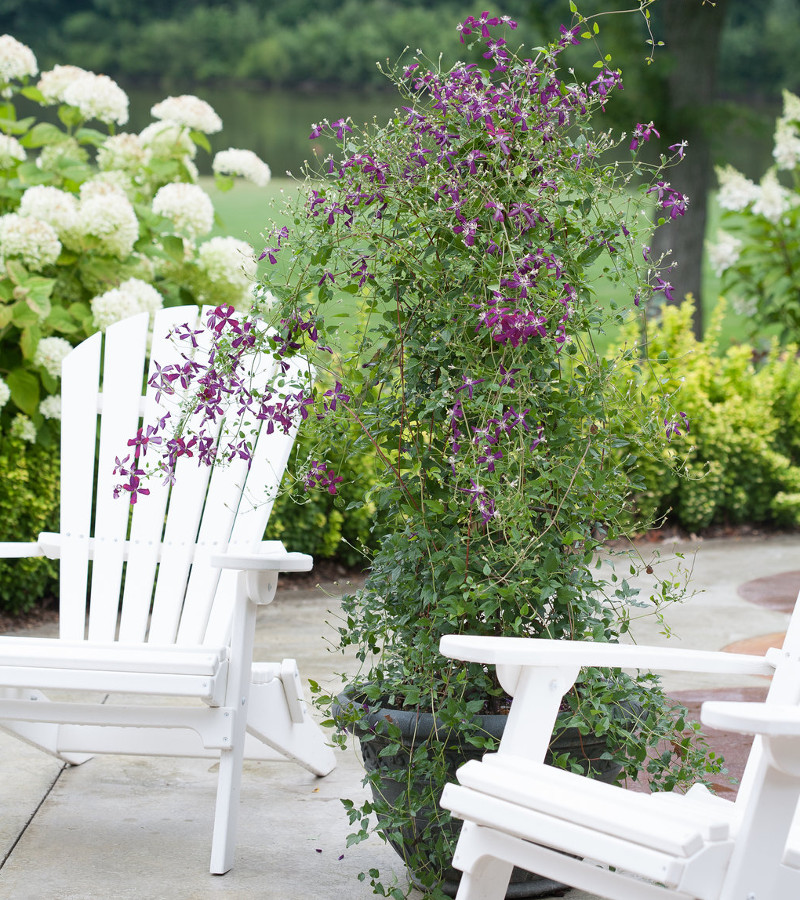Clematis are a flowering vine that bloom from spring to the first frost in the fall. Clematis can also sometimes be a shrub. In either scenario, it is possible to grow these in garden planters and the plants will do quite well with some special care. Gardeners will grow potted clematis in containers on patios, balconies, in the entryway of the home, on a deck or even in a modern garden.

Planting Clematis in Pots
Be sure to use a large container for clematis, because the extra soil in the planter will help protect the roots in the winter and during hot summer days. We recommend a planter at least 24 inches in diameter. The best material for the planter is resin plastic because terra cotta or ceramic planters can crack in the winter. Ensure the planter has drainage holes because the roots do not like wet feet.
The best time of year to plant clematis is in spring or fall. However you can also plant during the summer, but it will require more attention and care if planted in the summer. Clematis do best in a location that receives full sun, which is at least 6 hours of direct sunlight a day. That will help the plant produce the most flowers throughout the year.
Once you have planted the plant in the container, immediately add support for the vine. It is important to do this right away because the plant needs support. Also, adding support later on could damage the roots when you stick the support in the dirt.
 Best Soil For Clematis in Pots
Best Soil For Clematis in Pots
Us a potting soil mixture that is well draining. We also recommend mixing in compost or manure with the soil to provide more nutrients. In larger planters, some gardeners will add rocks to the bottom of the container for more drainage. However that is not necessary to do.
We also recommend adding a layer of mulch to the top of the soil. This will help the container retain moisture, add extra nutrients throughout the year, and provide extra protection to the roots during the winter.
Caring For Clematis in Planters
Clematis can do very well in containers if you provide extra care, especially the first 2 years the plant is growing and getting established. The main considerations are ensuring the plant is getting enough sunlight, there is good drainage in the container and the plant gets enough water.
Watering Clematis in Pots
Clematis growing in pots will require a lot more water than one growing in the ground. That is because containers will dry out faster than the ground. Check the soil frequently, especially in the first year. If the top inch of soil is dry the plant will need to be watered. Saturate the soil when watering.
No need to worry about providing too much water if the planter has good drainage.
Once established, the plant will need 1 inch of water per week. If it doesn’t get rainwater, you will have to provide the water. Check the soil more often during hot summer days and periods of drought.
Fertilizing Clematis in Pots
If you added manure or compost when planting the clematis, you do not need to fertilize again the first year. Once the plant is established, you can feed with rose fertilizer in the early spring each year. Use the directions on the bottle for applying the fertilizer.

Winter Care For Clematis in Pots
If you are growing the clematis in a ceramic pot, you should move the container to a place that will not freeze but still be cold enough to allow the plant to go dormant. If the container can withstand winter, then leave the plant where it's at. You can also choose a variety of clematis that is 1 growing zone up from where you live. So if you live in growing zone 6, choose a clematis that can grow up to growing zone 5. This will help ensure your clematis survives the winter.
Also, the plant will still need some water during the winter. Typically mother nature will provide enough, but keep a close eye on the plant to make sure it doesn’t stay dry for too long of a period.
Can Clematis Be Grown Indoors?
Clematis can be grown indoors, but it is not easy to do. The plants require at least 6 hours of direct sunlight. So it will need to be placed near a south facing window. Also, clematis do best if the plant is allowed to go dormant. The plants typically need at least 6 weeks of dormancy for best results the following year. The plants will also need support indoors. But this plant would make a very unique indoor plant and would make for a great experiment!
 |
Author Chris Link - Published 2-16-2020 |
